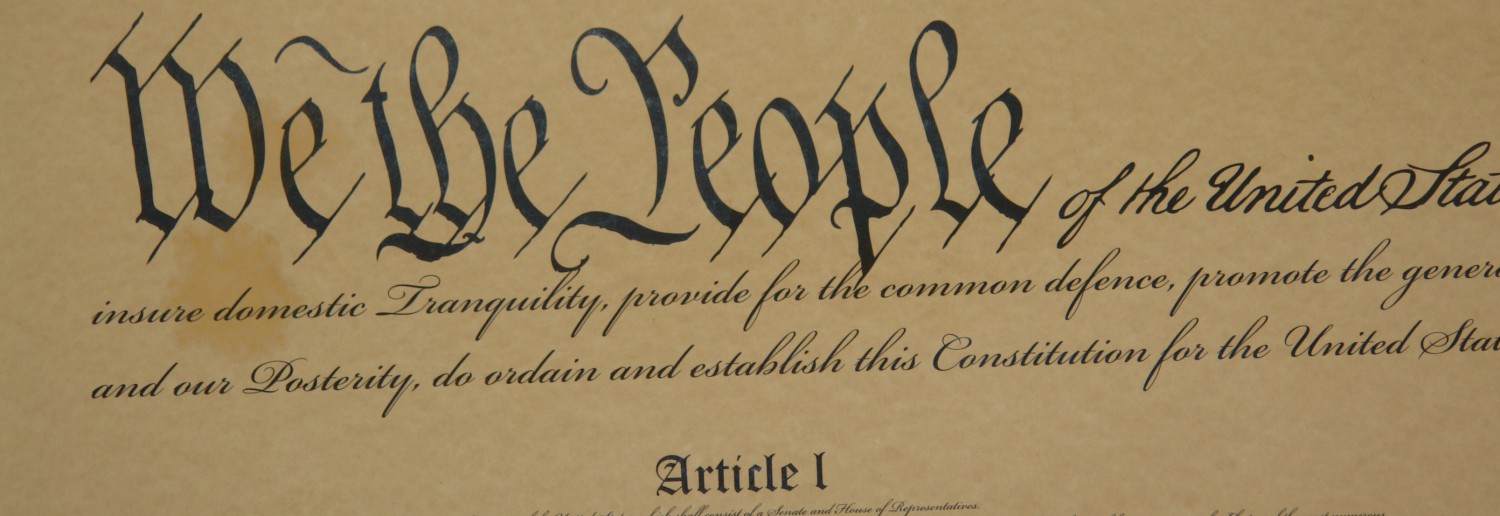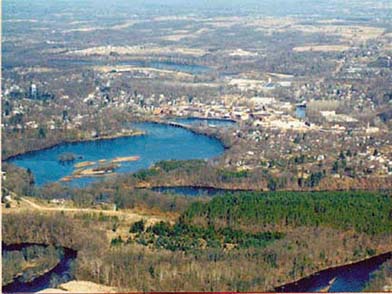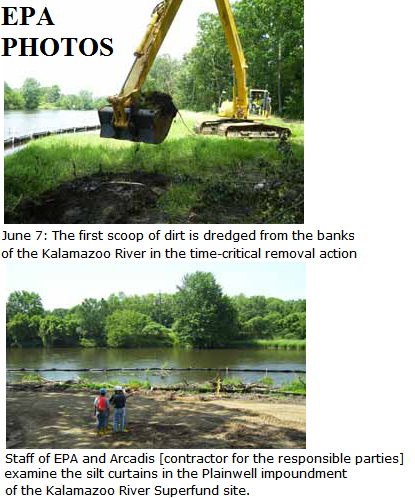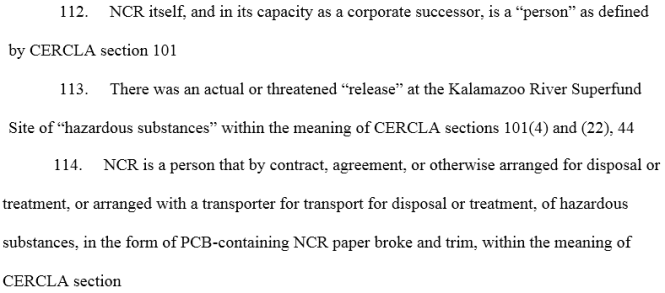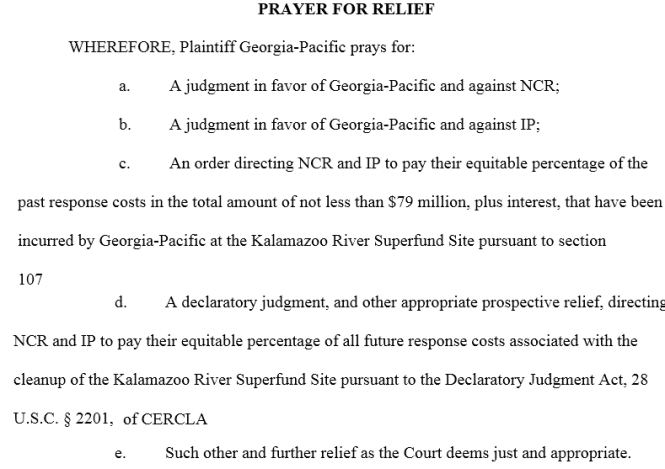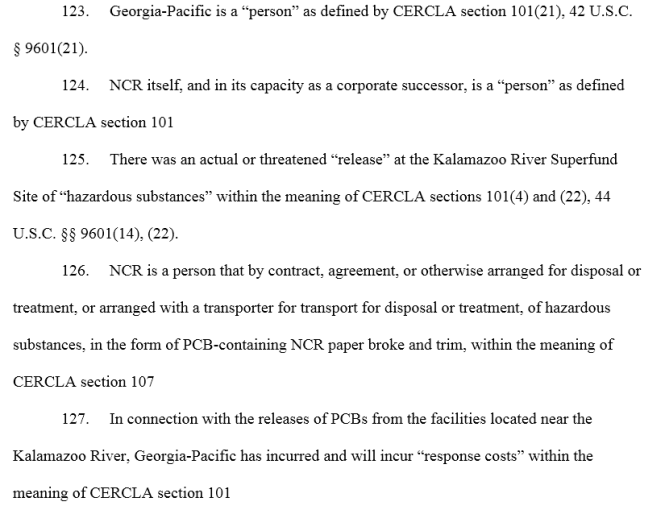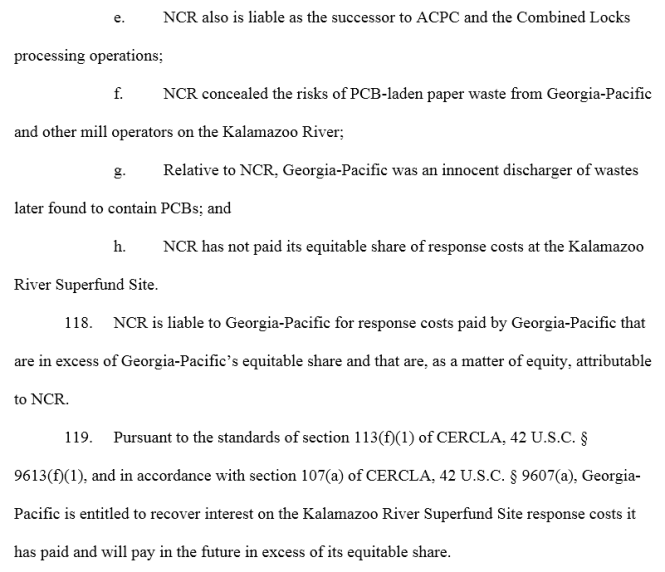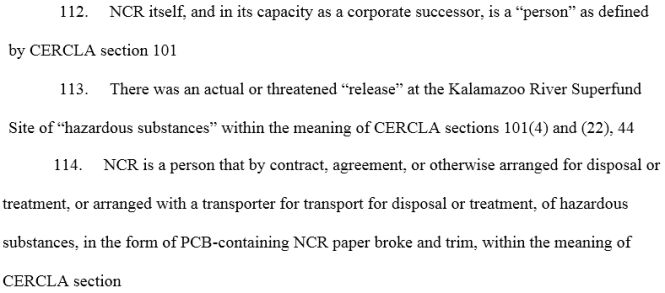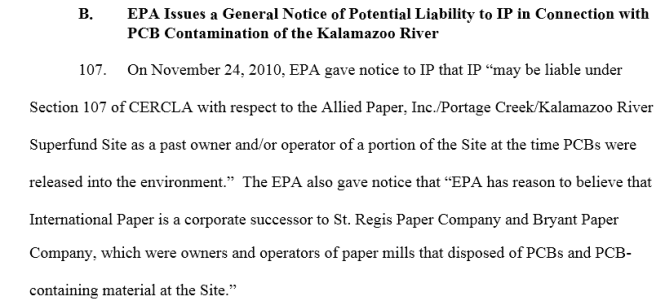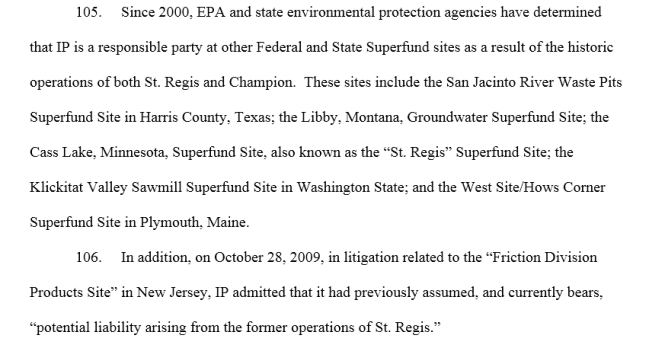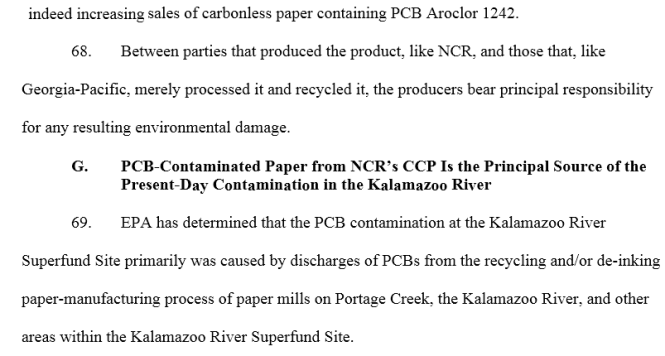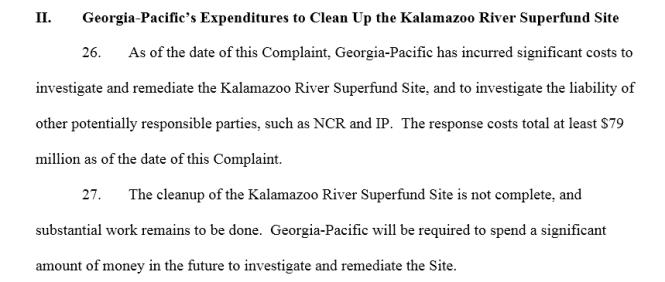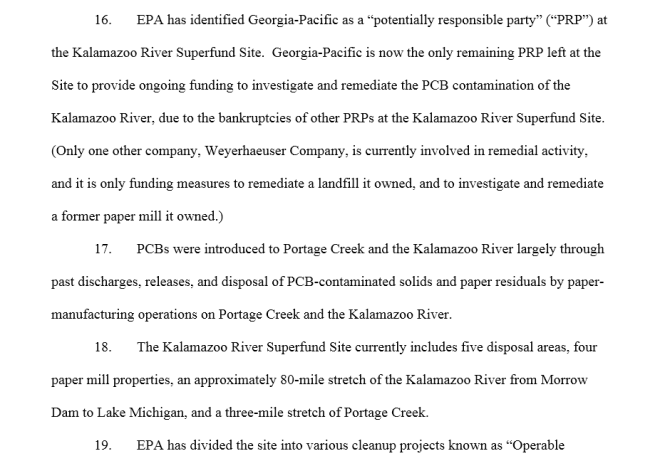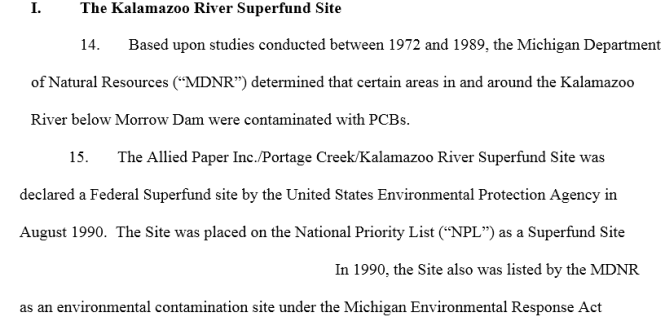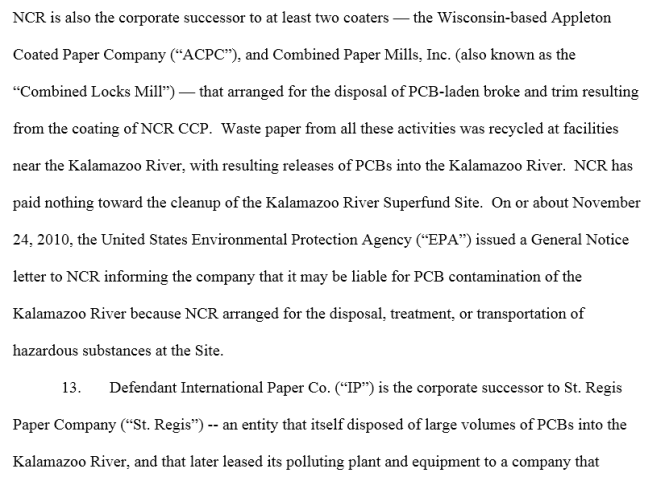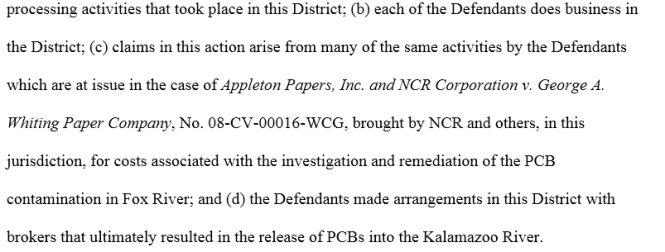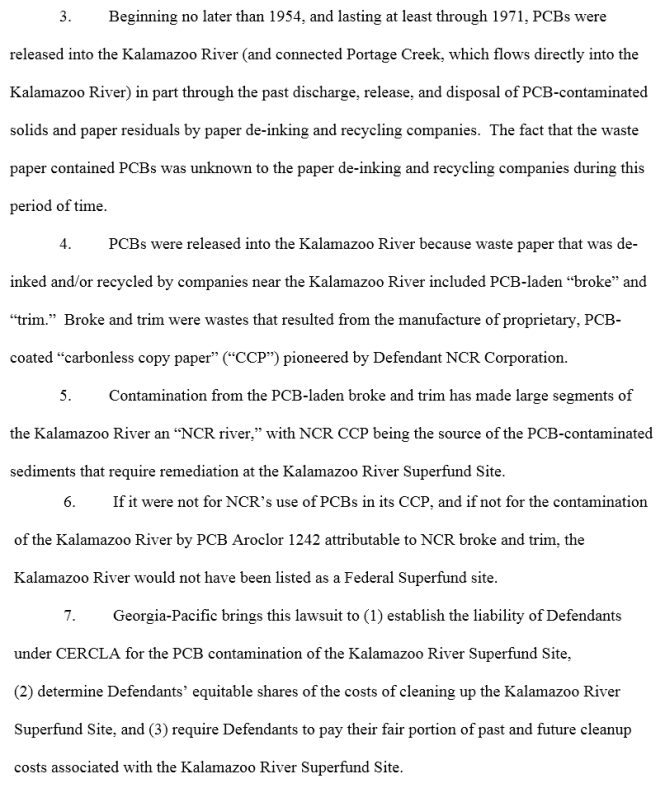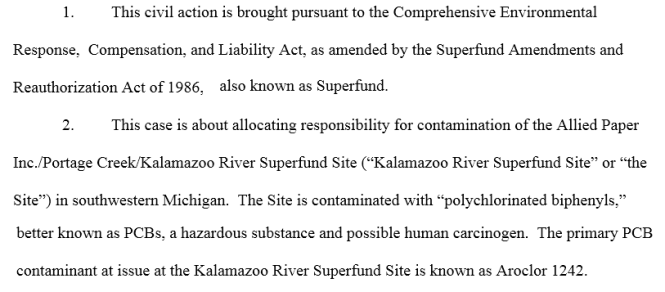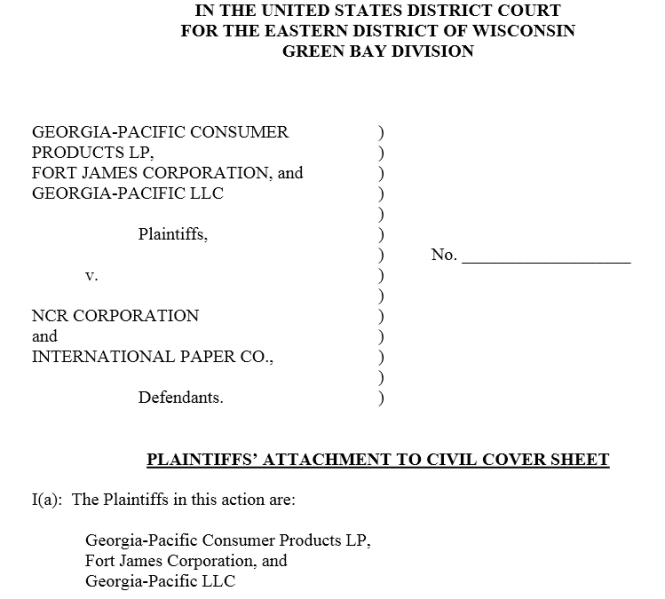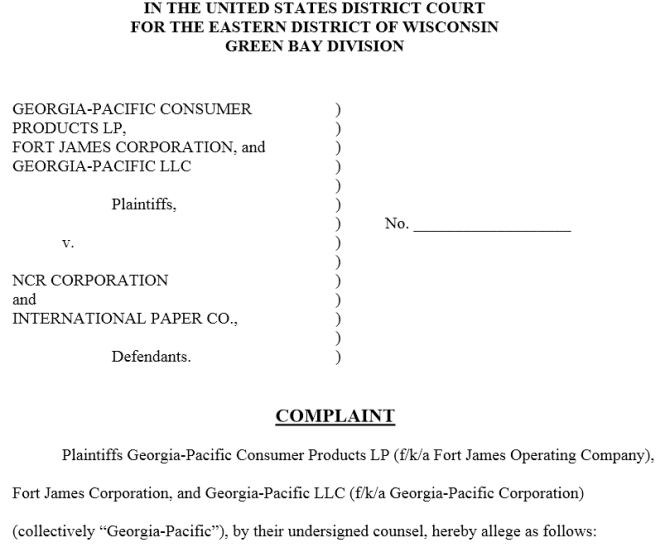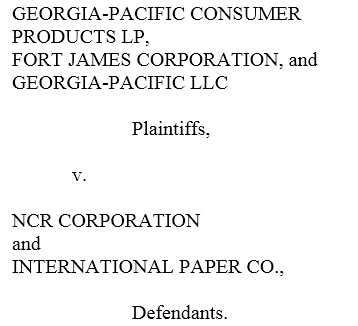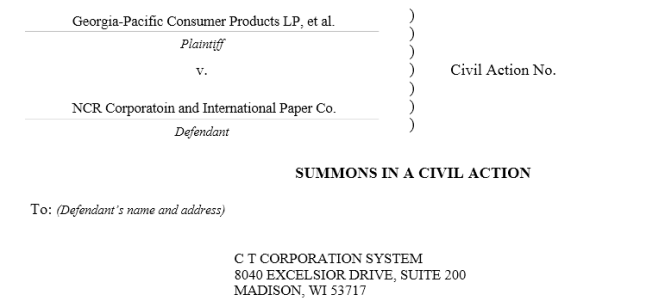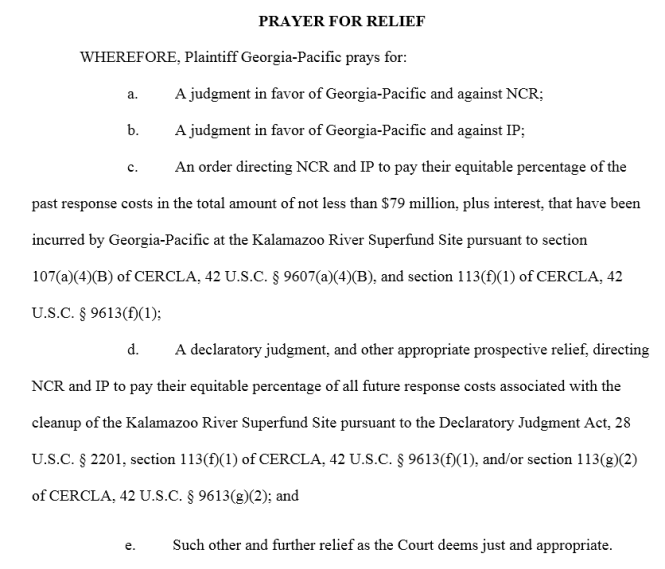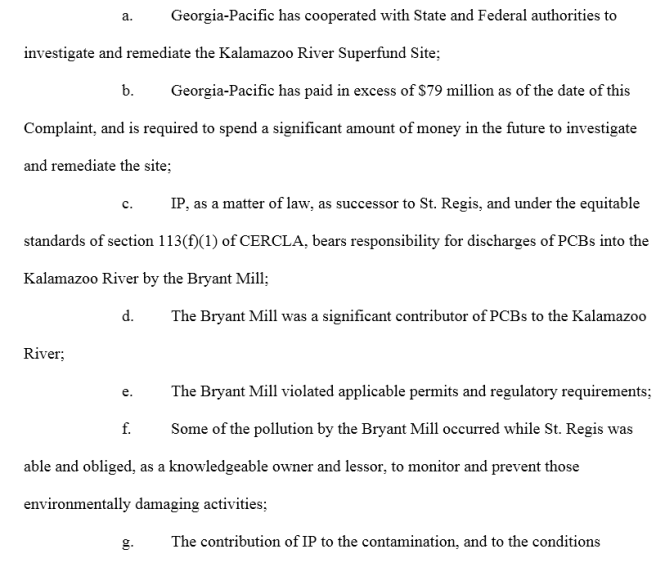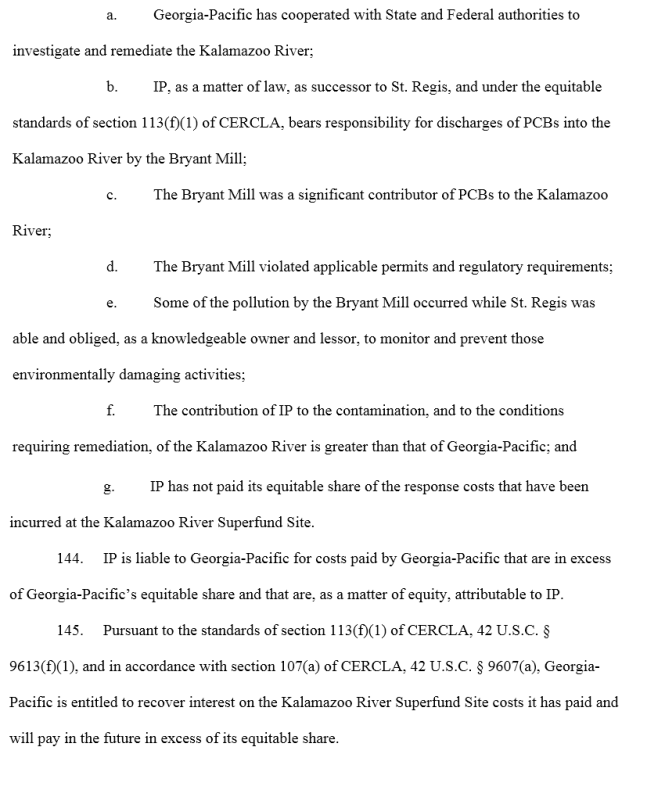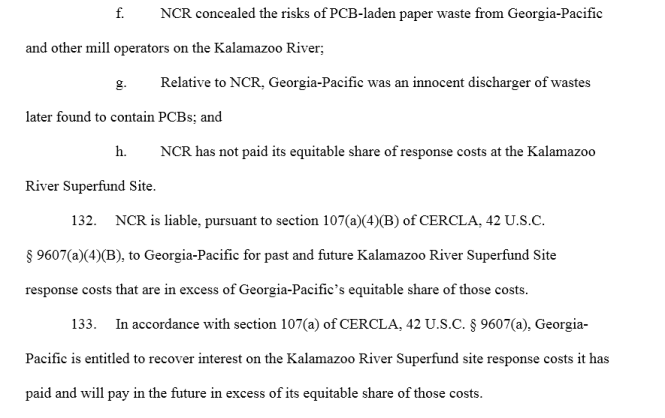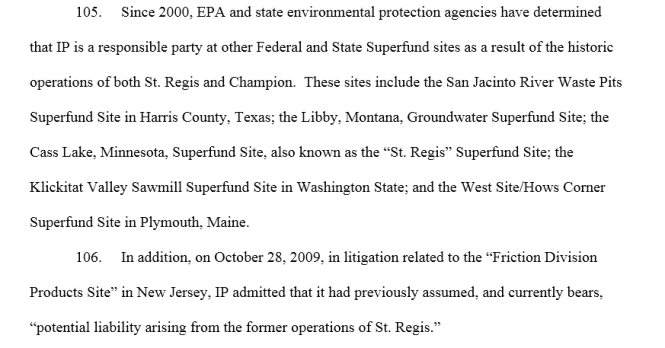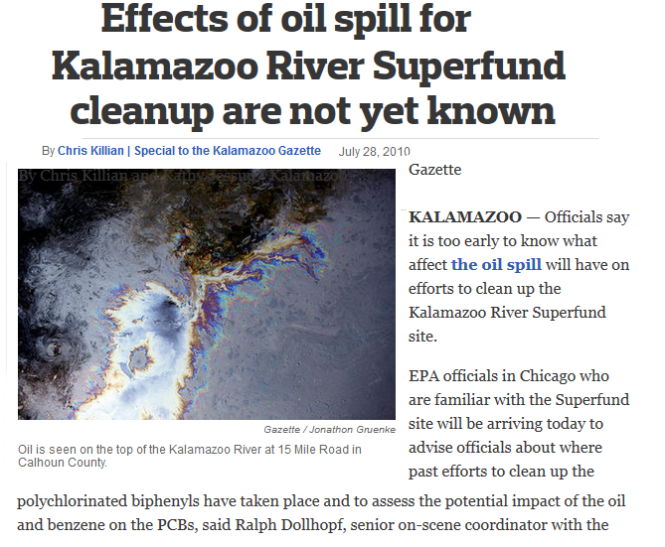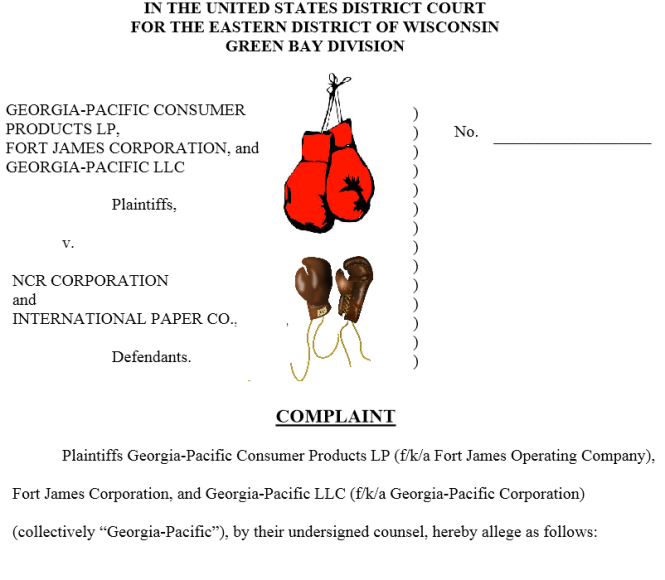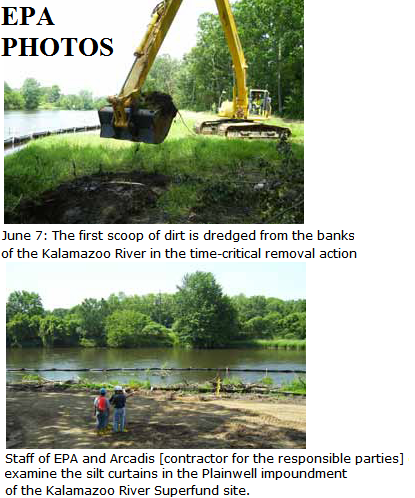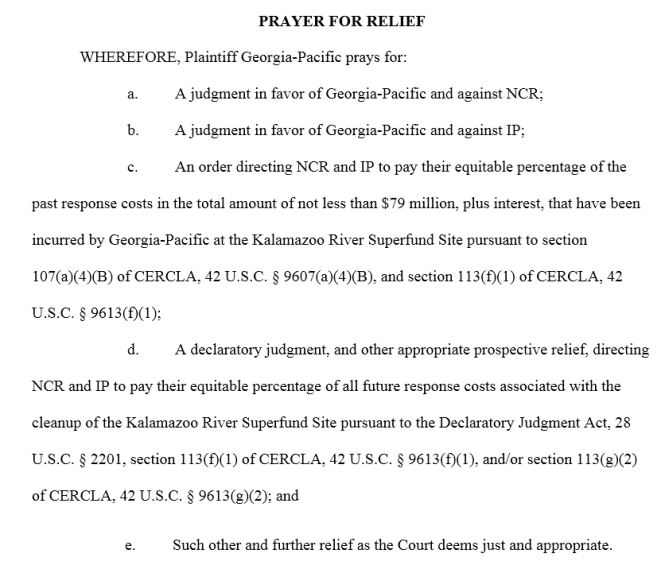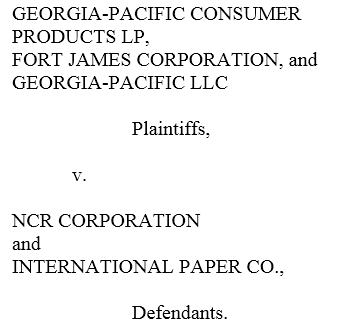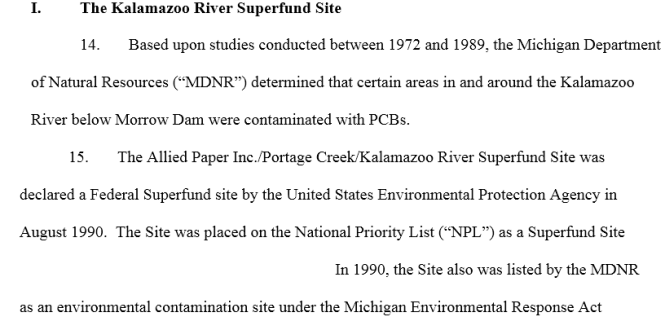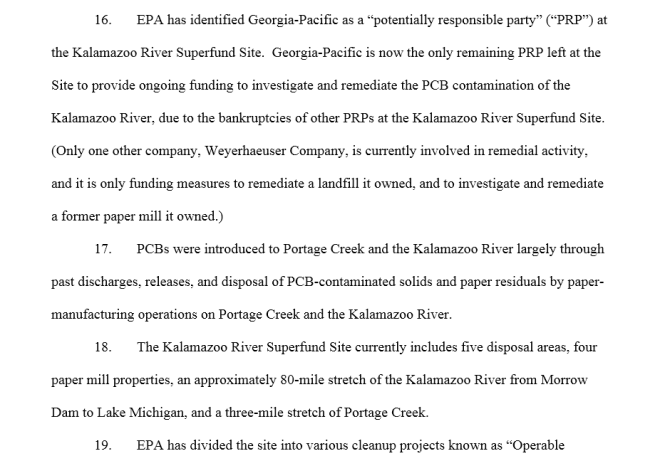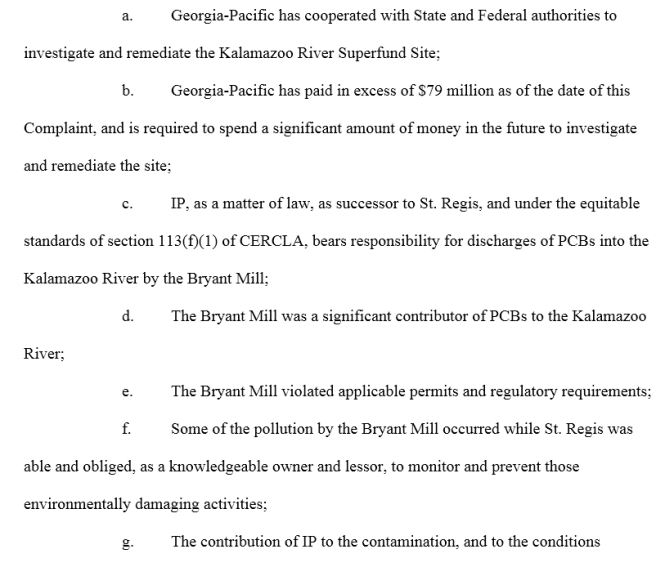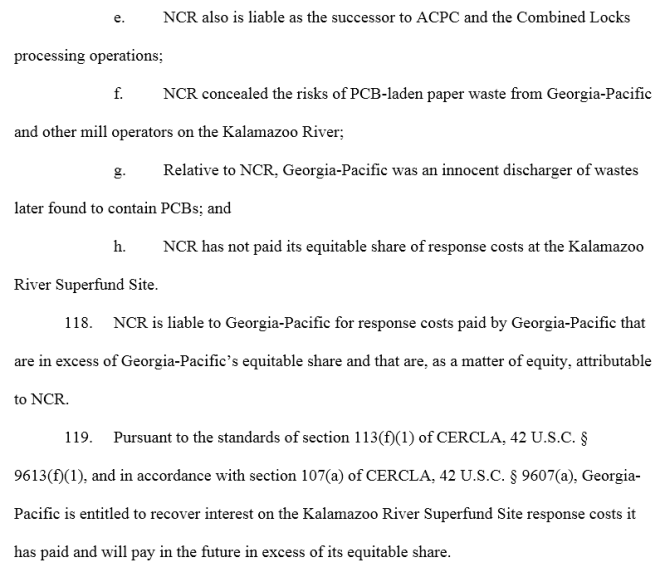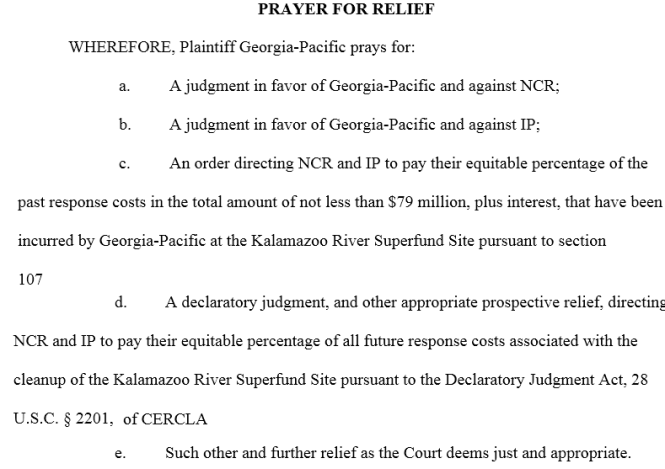From paper industry giants and insurance companies blaming each other for polluting famous rivers in two states – to the battle over what companies must pay billions of dollars in cleanup expenses – and even the discovery of five historic shipwrecks
A trial date just set in federal lawsuits and cleanup of the Kalamazoo River Superfund Site in Michigan
A federal judge takes steps to approve federal consent decrees in Fox River Superfund Site near Green Bay, Wisconsin by ordering $54 million set aside by those companies and governments responsible for the clean up
By Greg Peterson/Upper Peninsula Breaking News
UpperPeninsulaBreakingNews@gmail.com
(Kalamazoo, Michigan – Green Bay, Wisconsin) – Major developments today on a pair of Superfund clean up sites in two states involving major rivers that feed Lake Michigan.
A federal judge in Grand Rapids has just pushed back a trial date in a lawsuit involving paper industry giants battling over the costs of cleaning up the Kalamazoo River Superfund Site -. Meanwhile, a federal judge in Milwaukee appears close to approving a consent decree between paper industry corporations and governments to set costs for those involved in the Fox River Superfund Site.
On August 13, 2014, United States District Judge Robert J. Jonker in Grand Rapids set a September 22, 2015 trial date for phase II of the four-year lawsuit against NRC Corporation and International Paper Company by Plaintiffs Georgia-Pacific Consumer Products LP, Fort James Corporation, and Georgia-Pacific, LLC.
Judge Jonker ordered settlement conferences on April 15, 2015 and August 13, 2015 in Grand Rapids before Magistrate Judge Hugh W. Brenneman, Jr.
On September 26, 2013, federal Judge Jonker ordered that Defendants NCR Corporation and International Paper Company are liable parties that must pay for cleanup costs – however many other litigation issues remain involving the costs.
Paper Industry Giants continue fighting each other in United States federal courts – for millions of dollars in connection with the cleanup of the Kalamazoo River Superfund Site – and about a billion dollars for cleaning up the Fox River Superfund Site.
Fox River Superfund Site: $54 million in PCBs damage monies set aside as federal judge poised to approved consent decree: Governments and paper-related companies to admit their PCBs seriously hurt two American Indian nations in Wisconsin; pay cleanup costs
An “intergovernmental Memoranda of Agreement” has been reached by “parties” involved including the United States, the state of Wisconsin and the two tribes.
The federal consent decree forces the companies and governments involved to admit that two Native American tribes “have been injured by the PCB contamination,”according to the proposed decree obtained by Upper Peninsula Breaking News.
The tribal lands contaminated by PCBs are owned by the Oneida Tribe of Indians of Wisconsin (OTIW) and the Menominee Indian Tribe of Wisconsin (MITW).
Those who are part of the proposed decree are admitting that tribal lands were seriously damaged by the PCBs.
OTIW, MITW are the “tribal trustees for natural resources at and near that (Fox River Superfund) Site that have been injured by the PCB contamination,” the proposed decree states.
An “intergovernmental Memoranda of Agreement” has been reached by “parties” involved including the United States, the state of Wisconsin and the two tribes, according to the proposed decree.
“The United States, the State, and the Tribes are co-signatories to the proposed Consent Decrees,” the proposed decree states.
Federal Judge William C. Griesbach has ordered those involved in the consent decrees to put over $54 million dollars on deposit for when the decree is finalized:
- $1,350,000 by Kimberly Clark
- $5,200,000 by the City of Appleton
- $3,000,000 by CBC Coating, Inc.
- $13,700,000 by Menasha Corporation
- $5,200,000 by the Neenah-Menasha Sewerage Commission
- $14,700,000 by U.S. Paper Mills Corporation
- $12,200,000 by WTM I Company
- $100,000 by the State of Wisconsin
Meanwhile – the EPA in July 2014 filed its “Five-Year Review Report” on the status of the cleanup of the the Fox River Superfund Site.
The first proposed Federal Consent Decree is with the City of Appleton, CBC Coating Inc., Menasha Corporation, the Neenah-Menasha Sewerage Commission, U.S. Paper Mills Corporation, and WTM I Company.
Those six Settling Defendants would pay a total of $54 million toward the response costs and natural resource damages associated with the Fox River Superfund Site.
Under the Comprehensive Environmental Response, Compensation, and Liability Act (CERCLA), the companies realize they will be held responsible for cleanup.
The State of Wisconsin would pay an additional $100,000 to resolve its own potential CERCLA liability, as alleged in certain counterclaims asserted by some of the defendants in this case.
The second proposed Consent Decree is with Settling Defendant Kimberly-Clark Corporation.
Kimberly-Clark would pay the United States and the State a total of $1,350,000 under this de minimis settlement pursuant to CERCLA.
The third proposed Consent Decree is with Settling Defendant NewPage Wisconsin System Inc.
NewPage filed a petition for relief under Chapter 11 of the Bankruptcy Code in 2011.
As referenced in the proposed Consent Decree with NewPage, certain governmental claims against NewPage for the Fox River Site are potentially eligible for payment from a specially-established Fox River Reserve that is being administered by Liquidation Trust formed and governed in accordance with NewPage’s court-approved Reorganization Plan in its bankruptcy case.
The proposed Consent Decree with NewPage would grant the United States and the State allowed general unsecured claims for a total of $1,157,254 that would be paid as allowed claims by the Litigation Trust.
Because such claims are paid on a deeply-discounted basis under NewPage’s Reorganization Plan, the actual distributions that the
United States and the State will receive on those allowed claims may be as little as $50,000.
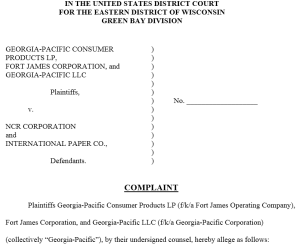 Plaintiffs Georgia-Pacific Consumer Products LP, Fort James Corporation, and Georgia-Pacific LLC – brought the multimillion dollar civil action against the other paper industry giants under the famous Superfund – that is used to clean up industrial sites after international corporations leave behind an environmental mess.
Plaintiffs Georgia-Pacific Consumer Products LP, Fort James Corporation, and Georgia-Pacific LLC – brought the multimillion dollar civil action against the other paper industry giants under the famous Superfund – that is used to clean up industrial sites after international corporations leave behind an environmental mess.
Called Superfund – officially its under the federal Comprehensive Environmental Response, Compensation, and Liability Act.
The suit states “the case is about allocating responsibility for contamination of the Allied Paper Inc./Portage Creek/Kalamazoo River Superfund Site – aka Kalamazoo River Superfund Site” or “the Site” in southwestern Michigan.”
Right now, Georgia-Pacific wants others to split the costs – $79 million or more.
A request basically approved by a judge – but more issues remain.
The paper companies identify the culprit as Aroclor 1242 – the cancer causing PCB left over from making Carbonless Copy Paper (CCP) using a process called “broke and trim.”
Contamination from the PCB-laden “broke and trim” has made large segments of the Kalamazoo River an “NCR river,” with NCR CCP being the source of the PCB-contaminated sediments that require remediation at the Kalamazoo River Superfund Sit, the suit states.
The plaintiffs (Georgia-Pacific) argue that the Kalamazoo River would not have been listed as a Federal Superfund site if “not for NCR’s use of PCBs in its CCP; and for the contamination of the Kalamazoo River by PCB Aroclor 1242 attributable to NCR broke and trim.
The lawsuit was filed on December 3, 2010 in two districts due to the wide range of issues and another Superfund site – the Fox River Superfund Site in Green Bay, Wisconsin.
Due to various legal connections with the Fox River Superfund Site, the cases were filed in the United States District Court For The Western District of Michigan, Southern Division and the United States District Court For The Eastern District Of Wisconsin Green Bay Division.
The following fascinating 2014 update on the Fox River Superfund Site from the EPA includes historic shipwrecks and progress paper companies are making in the cleanup:
“In a May 1, 2013, federal court ruling, U.S. District Judge William Griesbach required seven companies that EPA considers responsible for the PCB contamination to continue and complete the required cleanup work.
Three legal agreements for settlements totaling about $55 million were lodged in federal court on March 26, 2014.
If a judge approves these agreements, or consent decrees, this would resolve claims against six companies and two municipal sewer system operators for cleanup costs and natural resource damages in the Lower Fox River.
In April, the remaining portions of five historical ships were pulled out of the Lower Fox River just north of the southern “railroad bridge” in Green Bay.
This work was done under a legal agreement signed by EPA, Wisconsin Department of Natural Resources, the state historic preservation officer, Green Bay’s Neville Museum, and NCR Corp.’s contractor.
The ships, two of which date back to the 1880s, were discovered in 2008 by archaeologists hired to document artifacts found in the river from Appleton to Green Bay.
With the help of Wisconsin historians, nautical organizations and maritime museums, two were identified as the Bob Teed and the Satisfaction.
Little information is available on the three other wooden barges near the shoreline by the State Street sediment processing facility.
Six years ago, the archaeologists were charged with making recommendations on how to handle the ships, also referred to as artifacts, so the cleanup could proceed on schedule.
Because these sunken vessels are considered to be cultural resources, they must be ‘replaced’ if they are removed.
The paper companies have agreed to build a display for The Neville Public Museum of Brown County to ‘replace’ these resources.
The display is expected to be ready next year.”
The Kalamazoo Superfund Site is contaminated with PCBs – “Polychlorinated Biphenyls” – caused in the production of Carbonless Copy Paper (CCP).
PCBs are a hazardous substance and often connected to human carcinogen and kills wildlife.
The primary PCB contaminant at the Kalamazoo River Superfund Site is known as Aroclor 1242.
From 1954 through 1971, PCBs were released into the Kalamazoo River and connected Portage Creek (flows directly into the Kalamazoo River) partly through the past discharge, release, and disposal of PCB-contaminated solids and paper residuals by paper de-inking and recycling companies.
Georgia-Pacific/Fort James River Corp. wants the other paper giants (NCR Corporation and International Paper Co.) to pay their fair portion of past and future cleanup costs associated with the Kalamazoo River Superfund Site.
The fight between these wealthy paper-related behemoths arises from many of the same activities by the NCR Corporation and International Paper Co. – that are at issue in the case of Appleton Papers, Inc. and NCR Corporation v. George A. Whiting Paper Company (No. 08-CV-00016-WCG).
That suit brought by NCR Corporation (NCR) and others for costs associated with the investigation and remediation of the PCB contamination in the Fox River area.
In fact, last month (July 2014) the EPA released a “Five Year Review Report” on the Fox River Superfund Site cleanup plans.
On March 26, 2014, the EPA entered into “three Proposed Consent Decrees” – agreements between the EPA and several of the paper companies that polluted the Fox River:
- Consent Decree With Cashout Settling Defendants and the State of Wisconsin
- Consent Decree With Kimberly Clark
- Consent Decree With Newpage Wisconsin Inc.
The defendants made arrangements with brokers that ultimately resulted in the release of PCBs into the Kalamazoo River, the lawsuits claim.
Georgia-Pacific filed the lawsuit to establish the liability of Defendants and determine their equitable costs of cleaning up the Kalamazoo River Superfund Site, the suit states.
Georgia-Pacific wants to require the defendants to pay their fair portion of past and future cleanup costs associated with the Kalamazoo River Superfund Site.
The suit was also filed due to “claims in this action arise from many of the same activities by the Defendants which are at issue in the case of Appleton Papers, Inc. and NCR Corporation v. George A. Whiting Paper Company for costs associated with the investigation and remediation of the PCB contamination in Fox River” in Green Bay, the suit states
“And because the defendants made arrangements in this District with brokers that ultimately resulted in the release of PCBs into the Kalamazoo River.”
Georgia-Pacific is the corporate successor to Kalamazoo-area facilities that deinked and recycled PCB-containing NCR broke and trim.
Georgia-Pacific has paid in excess of $79 million to investigate and remediate the Kalamazoo River Superfund Site, the company states.
NCR invented the PCB-containing Carbonless Copy Paper (CCP) that has caused the PCB contamination of the Kalamazoo River Superfund Site, Georgia-Pacific alleges.
Plus GP alleges that NCR arranged for the disposal of PCB-laden waste from its own CCP converting operations.
Georgia-Pacific claims NCR arranged for the disposal of PCB-laden broke and trim from its contract coaters.
“Contract coaters” are the companies that used NCR’s coating (using NCR’s specifications) using an NCR emulsion.
NCR is also the corporate successor to at least two coaters — the Wisconsin-based Appleton
Coated Paper Company (ACPC), and Combined Paper Mills, Inc. (aka Combined Locks Mill).
Those companies arranged for the disposal of PCB-laden broke and trim resulting from the coating of NCR CCP, the suit states.
Waste paper from all these activities was recycled at facilities near the Kalamazoo River, with resulting releases of PCBs into the Kalamazoo River, according to Georgia-Pacific, putting most of the blame and expense on the other paper giant (NCR).
NCR has paid nothing toward the cleanup, Georgia-Pacific states in lawsuit.
The Michigan Department of Natural Resources (MDNR) conducted studies between 1972 and 1989 that “determined that certain areas in and around the Kalamazoo
River below Morrow Dam were contaminated with PCBs,” the suit states.
The Allied Paper Inc./Portage Creek/Kalamazoo River Superfund Site was declared a Federal Superfund site by the United States Environmental Protection Agency in August 1990.
In fact, the site was placed on the Superfund National Priority List (NPL).
In 1990, the site was listed by the MDNR as an environmental contamination site under the Michigan Environmental Response Act, the suit states.
EPA identified Georgia-Pacific as a “potentially responsible party” (“PRP”) at the Kalamazoo River Superfund Site.
Georgia-Pacific is now the only remaining PRP left at the Site to provide ongoing funding to investigate and remediate the PCB contamination of the Kalamazoo River, due to the bankruptcies of other PRPs at the Kalamazoo River Superfund Site, the suit states.
Only one other company is currently involved in remedial activity at the Kalamazoo.
Weyerhaeuser Company is funding measures to remediate a landfill it owned, and to investigate and remediate a former paper mill it owned, the suit claims.
PCBs were introduced to Portage Creek and the Kalamazoo River largely through past discharges, releases, and disposal of PCB-contaminated solids and paper residuals by paper manufacturing operations on Portage Creek and the Kalamazoo River, the suit charges.
The Kalamazoo River Superfund Site currently includes five disposal areas, four paper mill properties, an approximately 80-mile stretch of the Kalamazoo River from Morrow Dam to Lake Michigan, and a three-mile stretch of Portage Creek, the suit states.
There are several areas that need total cleanup, the suits state:
Operable Unit 1 is the Allied Paper/Bryant Mill Pond Operable Unit
Operable Unit 2 (Willow Boulevard/A-Site Landfill)
A groundwater investigation was undertaken in the summer of 2009 at Operable Unit 2 (Willow Boulevard/A-Site Landfill),the suit states
In September 2009, a consent decree was signed between the EPA and Georgia-Pacific for design and cleanup at the Willow Boulevard/A-Site Landfill was approved by the Federal District Court.
This decree/settlement, among other things, obligates Georgia-Pacific to consolidate waste materials, construct a permanent landfill cap, and install a groundwater monitoring system.
Operable Unit 3 is the King Highway Landfill
The remedy involves the construction of a landfill cap, the seeding of the cap with vegetative growth, and the construction of a gas collection trench (under the control of the State of Michigan).
Operable Unit 4 is the Twelfth Street Landfill
In September 2001, EPA san agreement and the remedy includes excavation of PCB residuals that have migrated from the landfill and placement of those residuals back in the landfill. This work is conducted by Weyerhaeuser with oversight by EPA and MDNR.
Operable Unit 5 concerns the Portage Creek and Kalamazoo River sediments
In February 2007, EPA reached two settlement agreements with Millennium Holdings
LLC (which has since gone bankrupt) and with Georgia-Pacific.
The agreements were the result of two years of mediated negotiations between the possible responsible parties (PRPs) and various government regulators and entities, including the EPA and the State of Michigan.
Georgia-Pacific and Millennium agreed to perform sediment excavation in the Kalamazoo River near Plainwell, Michigan, the suit states.
Georgia-Pacific and Millennium agreed to conduct a Supplemental Remedial Investigation/Feasibility Study (Supplemental RI/FS) on the 80-mile stretch of the Kalamazoo River from Morrow Dam to Lake Michigan and Portage Creek from Cork Street to the confluence with the Kalamazoo River.
Georgia-Pacific’s Expenditures to Clean Up the Kalamazoo River Superfund Site:
Georgia-Pacific has spent at least $79 million dollars (as of Dec. 2010) to investigate and remediate the Kalamazoo River Superfund Site, and to investigate the liability of other potentially responsible parties, such as NCR and International Paper.
You can read the originals:
Read or download Lawsuit Filed Between Paper Giants 12-3-10
Read or download the Georgia-Pacific vs NCR financial ruling 9-26-13
https://en.wikipedia.org/wiki/Carbonless_copy_paper
http://www.cdc.gov/niosh/docs/2001-107/
http://www.google.com/patents/US2730457
http://www.sec.gov/Archives/edgar/data/1144326/000114432613000031/R18.htm
Kalamazoo River Superfund Site
http://www.epa.gov/region05/cleanup/kalproject/index.htm
http://www.michigan.gov/deq/0,4561,7-135-3304-84646–,00.html
https://en.wikipedia.org/wiki/Kalamazoo_Superfund_Site
http://www.fws.gov/midwest/es/ec/nrda/KalamazooRiver
http://www.kalamazoorivercleanup.org
https://www.kzooriver.com/kalamazoo
http://www.epa.gov/region5/cleanup/kalproject/images/OUmap.gif
http://www.epa.gov/region5/cleanup/kalproject/photos.htm
Photo of “Portage Creek – Kalamazoo River, Michigan” by EPA
www.michigan.gov/images/main_82481_7.jpg
“<a href=”http://commons.wikimedia.org/wiki/File:Portage_Creek_-_Kalamazoo_River,_Michigan.jpeg#mediaviewer/File:Portage_Creek_-_Kalamazoo_River,_Michigan.jpeg”>Portage Creek – Kalamazoo River, Michigan</a>” by EPA – <a rel=”nofollow” class=”external free” href=”http://www.michigan.gov/images/main_82481_7.jpg”>http://www.michigan.gov/images/main_82481_7.jpg</a>. Licensed under Public domain via <a href=”//commons.wikimedia.org/wiki/”>Wikimedia Commons</a>
Check out the seeps at base of TP1, Elizabeth Copper Mine Superfund Site Vermont, USA – Important to Upper Peninsula residents because of the pollution feared by sulfide and copper mining across northern Michigan near Lake Superior
U.S/ Environmental Response, Compensation, and Liability Act (CERCLA)
www.epa.gov/superfund/policy/cercla.htm
http://en.wikipedia.org/wiki/Superfund
http://www.epa.gov/agriculture/lcla.html
U.S. Damage Assessment, Remediation & Restoration Program (DARRP)
www.darrp.noaa.gov/greatlakes/kalamazoo
www.westonsolutions.com/projects/project_kalamazooriver.htm
www.terracontracting.net/Multimedia/Video/TabId/74/VideoId/6/Kalamazoo-River-Superfund-Site.aspx
Kalamazoo River Watershed Council (KRWC)
http://kalamazooriver.org/?page_id=217
The Environmental Law Reporter
http://upton.house.gov/uploadedfiles/05_13_2014_congressional_letter_to_epa_re_kalamazoo_superfund.pdf
http://caselaw.findlaw.com/us-6th-circuit/1022237.html
http://www.thefederalregister.com/d.p/2014-02-18-2014-03332
http://onlinelibrary.wiley.com/doi/10.1897/04-493R.1/abstract
www.msu.edu/user/giesy/Projects/Presentations/KZ-SS-BE-01.pdf
Authorizing federal defendant deposits in consent decree Fox River Superfund Site
Authorizing federal defendant deposits in consent decree Fox River Superfund Site
EPA Five-Year Review Reports
July 2014 Five Year Review Report (PDF) (68 pp, 4.9MB)
Notice of Lodging of Three Proposed Consent Decrees (PDF) (7pp, 41K), March 26, 2014
Consent Decree With Cashout Settling Defendants and the State of Wisconsin (PDF) (59 pp, 980K), March 26, 2014
Consent Decree With Kimberly Clark (PDF) (32 pp, 541K), March 26, 2014
Consent Decree With Newpage Wisconsin Inc. (PDF) (30 pp, 617K), March 26, 2014
www.epa.gov/Region5/cleanup/foxriver
www.epa.gov/Region5/cleanup/foxriver/#updates
United States Department of Justice aka United States Justice Department
http://www.justice.gov/enrd/3643.htm
Fox River groups, info:
https://en.wikipedia.org/wiki/Fox_River_%28Wisconsin%29
http://www.foxriverwatch.com/NCR_corporation.html
http://www.foxriverwatch.com/pcb_pcbs_sources_1.html
http://www.foxriverwatch.com/superfund_sediment_remediation.html
http://dnr.wi.gov/topic/greatlakes/greenbay.html
http://www.sevenson.com/index.php/project-summaries/fox-river-superfund-site/
Appvion, Inc. (formerly Appleton Papers Inc.)
https://www.linkedin.com/company/appleton
http://www.appletoncoated.com/index.php?GroupID=11
http://www.appletoncoated.com/greenzone/index.php
Info on lawsuits:
http://www.law360.com/articles/213303/gp-wants-ncr-to-pay-for-mich-superfund-site
http://www.law360.com/companies/ncr-corporation/articles
http://www.mlive.com/news/kalamazoo/index.ssf/2013/09/hold_portage_creek_pcb_cleanup_1.html
http://michiganradio.org/post/federal-regulators-say-pcb-cleanup-kalamazoo-river-gaining-momentum
http://michiganradio.org/post/pcb-cleanup-continues-along-kalamazoo-river
http://michiganradio.org/post/kalamazoo-residents-struggle-epa-over-mount-pcb
http://michiganradio.org/post/epa-says-decision-about-kalamazoo-s-mount-pcb-will-come-summer
http://michiganradio.org/post/kalamazoo-rallies-pressure-epa-remove-hazardous-paper-mill-waste
http://www.sec.gov/Archives/edgar/data/1144326/000114432613000031/R18.htm
American College of Environmental Lawyers (ACOEL)
http://www.acoel.org/file.axd?file=2013%2F10%2FGeorgia%2BPacific%2Bv%2BNCR.pdf
Kalamazoo River Superfund Site:
8-22-14 Extending Time For IPC To Respond To NCR Corporation Motion
8-13-14 Reply Brief In Support of Motion To Establish Scope of Phase II Trial
8-8-14 NCR Corp’s Interrogatories to the Other Parties
8-13-14 Amended Order Revising Case Schedule And Addressing Motions
http://www.law360.com/articles/428041/liberty-mutual-fights-ncr-on-79m-superfund-site-coverage
http://www.epa.gov/region5/cleanup/foxriver/pdf/foxriver_cd_201010.pdf
Appleton Papers, Inc.
United States of America and the State of Wisconsin, Plaintiffs–Appellees, v. NCR Corporation, Defendant–Appellant No. 12–2069 August 3, 2012
http://caselaw.findlaw.com/us-7th-circuit/1608058.html
http://fox11online.com/2014/05/15/objections-filed-to-proposed-fox-river-cleanup-settlement
Lawsuit Filed Between Paper Giants 12-3-10 Georgia-Pacific vs NCR financial ruling 9-26-13
An August 2014 EPA update on the Fox River Superfund Site:
EPA has completed a status review of the site’s cleanup. This type of review is required at least every five years where the cleanup is complete–or ongoing–but hazardous waste remains managed on-site. These reviews are done to ensure that the cleanup continues to protect people and the environment.
EPA Five-Year Review Report (PDF) (68 pp, 4.9MB) July 2014
The review included:
An evaluation of background information
Cleanup requirements
Effectiveness of the cleanup and any anticipated future actions
An analysis of ways for EPA to operate more efficiently.
This was the second five-year review for the Lower Fox River site.
It details the site progress. The previous review was done in 2009.
The sixth year of dredging in the Lower Fox River from DePere to Green Bay is in progress. About 670,000 cubic yards of PCB-contaminated sediment is expected to be removed this year using at least three hydraulic dredges.
Similar to last year, dredging will take place 24 hours per day, at least five days a week through early November (except for holidays).
Another process referred to as sand capping and covering, which started in 2011, will also continue. This year, 60 acres of sediment will be capped and covered.
All dredged sediment is pumped into the State Street dewatering facility through a pipeline.
Then, the water is squeezed out by special equipment called a plate and frame press.
The remaining dried sediment is loaded onto trucks to be properly disposed of. Some sediment with higher levels of PCBs is trucked to Ridgeview Recycling and Disposal Facility in Whitelaw, near Manitowoc.
Owned by Waste Management of Wisconsin, this landfill received a permit in 2012 from the Wisconsin Department of Natural Resources to accept this type of material.
Since most of the sediment has PCB levels less than 50 parts per million, it is taken to Veolia Hickory Meadows Landfill in Chilton.
The entire cleanup is scheduled to be completed by 2017.
In a May 1, 2013, federal court ruling, U.S. District Judge William Griesbach required seven companies that EPA considers responsible for the PCB contamination to continue and complete the required cleanup work.
